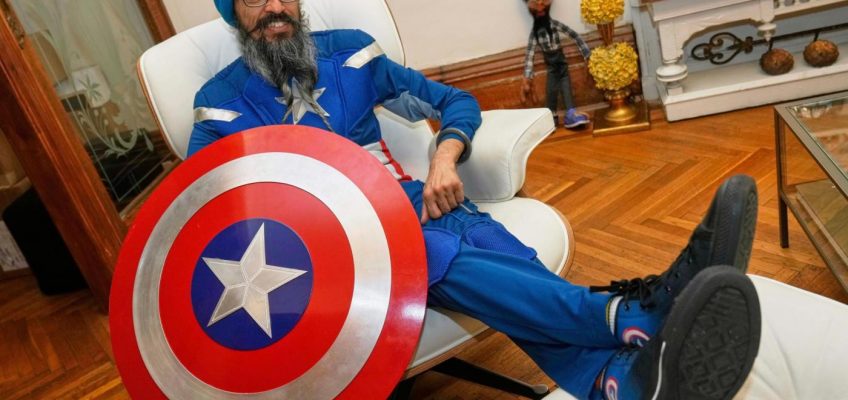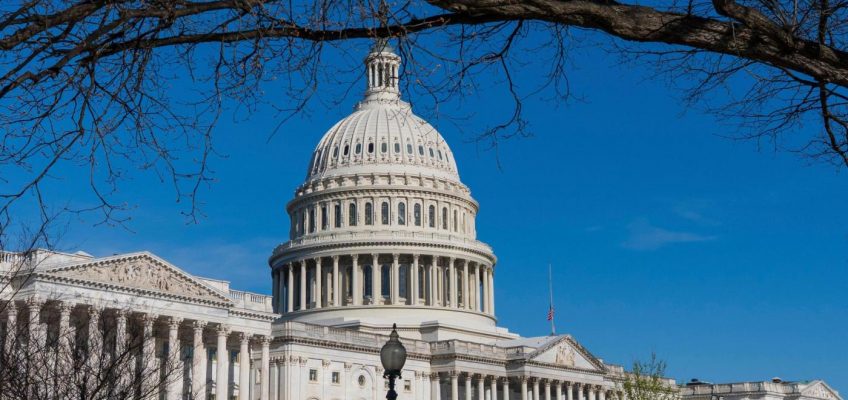By DEEPA BHARATH, Associated Press
“Captain America doesn’t wear a beard and a turban, and he’s white.”
Vishavjit Singh looked at the boy who uttered those words, and then he looked at himself — a skinny, bespectacled, turbaned, bearded Sikh in a Captain America suit.
“I wasn’t offended, because I knew that this kid was going to have this image of me, a Sikh Captain America, forever in his mind,” Singh said. “This image has so much power to it that it opens up conversations about what it means to be American.”
Vishavjit Singh, who educates youth about Sikhism through his Captain Sikh America character, poses for a portrait in costume at home, in New York’s Harlem neighborhood, Friday, May 30, 2025. (AP Photo/Richard Drew)
Representation of non-Abrahamic religions and spiritual traditions, particularly in the mainstream comics universe, is minimal. Even when they are portrayed in comics, their presentation, as Singh and others in the field point out, is often inauthentic and sometimes negative.
Recently, however, comic book writers and academics who study the intersection of religion and comics observe a renaissance of sorts, which they say is happening because people close to these faith traditions are telling these stories with a reverence and sincerity that resonate with a wider audience.
A Sikh superhero with a message
Singh’s journey to make that connection began after the attacks of Sept. 11, 2001, triggered anti-Sikh hate incidents. Having faced hate and exclusion throughout his life, he decided to spread his message of kindness and inclusion by capitalizing on the appeal of comics and superheroes — an area where he found Sikh representation to be “virtually zero.”
He suited up as Captain Sikh America in Manhattan for the first time in summer 2013 — one year after a self-proclaimed white supremacist opened fire inside a Sikh temple in Oak Creek, Wisconsin, killing six and injuring four others.
New York’s reaction to Captain Sikh America was joyous.
“Strangers came up and hugged me,” Singh said. “Police officers wanted photos with me. A couple wanted me to be part of their wedding ceremony. I felt I had a certain privilege I’d never had before.”
In 2016, Singh gave up his full-time job to travel around the country to schools, government agencies and corporations to share his story and educate youth about his culture and faith. He doesn’t speak directly about religion but rather the core values of Sikhism.
“I talk about equality, justice and about the universal light being present in every speck of creation,” he said.
Africana religions in comics
Marvel’s Black Panther heralded better representation for Africana religions in the U.S., according to Yvonne Chireau, a professor of religion at Swarthmore College in Pennsylvania. However what is seen in Black Panther or other comics is a synthesis of different African religions and cultural practices, she said.
For example, one page might talk about the Orishas, divine spirits that play a key role in the Yoruba faith of West Africa, while another might feature Egyptian gods. One of the first superheroes with African religious roots, Chireau said, was Brother Voodoo, created in the 1970s by Marvel publisher Stan Lee, writer Len Wein and artist John Romita. He was the first Haitian superhero.
The turn of the last century was a time of revival for Black-centric comics, she said, adding that immigration from African and Caribbean countries, including Haiti, led to increased understanding of religious practices originating in those places.
“It’s definitely gotten a lot better and much more authentic because the people who are telling these stories care about those religious practices,” she said.
Incorporating Black mythology and spirituality
Brooklyn-born Haitian American comic book writer Greg Anderson Elysée said he didn’t learn about African and Caribbean religious traditions until he was a teenager. Elysée was raised Catholic, but he now considers himself agnostic. For the past decade, he’s written comics about Is’nana, the son of Anansi the Spider, the god of wisdom, knowledge and mischief in the Akan religion of West Africa.
This image provided by Greg Anderson Elysee shows six covers from Greg Anderson Elysée’s Is’nana comics series about the adventures of the son of Anansi the Spider, a god in the Akan religion of West Africa. (Greg Anderson Elysée via AP)
What drives his vision and his creativity, Elysée said, is the need to see more Black mythology, deities and spirituality showcased with the same level of respect as European fairy tales and Greek mythology.
“When I went looking for anything on African spirituality in the bookstore, I found it in the occult section as opposed to the religion or mythology section,” he said. Common depictions of African faith as voodoo and witchcraft are colonialist narratives aimed at demonizing Indigenous spiritual practices, he added.
“When I started going to ceremonies and rituals, I saw how much power there is in it. When we know who we are — whether you believe in the religion or not — it fills you with joy, a purpose and a sense of being.”
Elysée is excited and relieved by the reaction to his work.
“While this is entertainment, you also don’t want to offend those who believe in it and truly get so much power from it,” he said. “Some of my portrayals of these religions in my comics may not be 100% authentic, but there is a level of research and respect that goes into every piece of it.”
Zen comics that heal, ground and center
Zen Buddhism has informed much of John Porcellino’s work. For over three decades, he has produced and self-published King-Cat Comics and Stories, a largely autobiographical mini-comic series. Porcellino was drawn to Buddhism in his 20s after what he describes as a period of intense mental suffering and health problems.
As a punk rock fan, Porcellino saw commonalities between punk and Zen because “they are both concerned with the essence of things rather than appearances.” Both are ways of life — simple yet nuanced.
This image provided by John Porcellino shows “The Weight of my Bones” by John Porcellino, part of his King-Cat Comics and Stories, his long-running series that reflects the author’s Zen practice. (John Porcellino via AP)
He gave the example of a wordless story titled “October,” featured in King-Cat’s 30th issue, that shows him as a high school student walking home one night from school. When he gets home, his mom asks him to take the dog outside; as he steps out, he sees the stars.
“It’s the experience of being in everyday, mundane life … and then suddenly breaking through to some kind of transcendence,” he said.
Porcellino views these comics as a healing presence in his life.
“They are an important part of my spiritual practice,” he said. “Any time I have a major crisis in my life, my first reaction is to sit down and start making comics and put my focus into that. It just helps ground me.”
This image provided by John Porcellino shows “Non-thinking” by John Porcellino is part of his King-Cat Comics and Stories, a long-running series that reflects the author’s Zen practice. (John Porcellino via AP)
Why representation matters for children
Teresa Robeson, who wrote a graphic novel about the 14th Dalai Lama, said that even though her mother was Catholic and raised her in the faith, her grandmother was Buddhist. She grew up in Hong Kong, with memories of relatives praying to Buddhist gods, taking in the fragrance of burning incense and the sound of Buddhist chants.
Though she practices neither Catholicism nor Buddhism at this time, Robeson jumped at the opportunity to tell the story of the Dalai Lama in graphic novel form because the book focused on a pivotal moment in the spiritual leader’s life, when he fled Tibet for India after the Chinese occupation.
This image provided by Penguin Random House LLC, shows the book cover of “Who Is Tibet’s Exiled Leader?: The 14th Dalai Lama” (Penguin Random House LLC via AP)
Robeson liked the idea of representing a religion and culture that do not get much attention in media.
“Children’s books are like mirrors and windows for kids,” she said. “It’s helpful especially for children of immigrants who don’t often see themselves in mainstream literature. They don’t see anyone who looks like them or prays like them. At the same time, it also helps kids who are not Asian or Buddhist to learn something about those communities.”
The comics renaissance in India
Amar Chitra Katha was a comic book company started by the late Anant Pai in Mumbai in 1967 as a way to teach Indian children about their own mythology and culture. The first title was “Krishna,” an important god in Hinduism and protagonist of the Bhagavad Gita, one of the religion’s main sacred texts.
Movie review: ‘John Wick’ spinoff ‘Ballerina’ twirls beautifully but aimlessly
Dr. Beach names top 10 beaches for 2025. Here’s the list
‘Stick’ review: Owen Wilson scores in a comedy about golf, mentorship and picking yourself up from your lowest lows
Movie review: Ana de Armas is better at killing than ballet in ‘Ballerina,’ a John Wick spinoff
Walmart’s army of bakery decorators take the cake when it comes to hourly store pay
Pai was an engineer turned comic books seller who used varied marketing techniques, including walking around with planks, nails and hammers in his bag so he could build shelves for bookstores that refused to display his comics because they lacked shelf space, said Reena I. Puri, the company’s managing director and a 35-year veteran of the business.
Pai started with Hindu mythology and gods but soon expanded to other faiths, releasing a globally successful comic titled “Jesus Christ” and others about Buddha, Sikh gurus and Mahavira, who founded Jainism. Later came secular comics about historical figures and folktales.
But religion remains the mainstay of Amar Chitra Katha, and books that teach children about faith, history and culture are also the most popular in the diaspora, Puri said.
“Most recently we’ve also portrayed (Indigenous) religions and have gathered folktales relating to these traditions from all over India,” she said.
Amar Chitra Katha comics faced criticism in the past for their portrayal of gods as fair-skinned and “asuras” — often the antagonists to the gods — as dark-skinned with demonic facial features. But that has changed, Puri said.
“We’ve educated ourselves and realized that our ancient texts were not as racist or colorist as we may be today,” she said. “We’re correcting those misconceptions now.”
Atheism, paganism and … Lucifer
British comic book writer Mike Carey is known for his 2000-2006 DC Comics series “Lucifer,” which depicts the titular character’s adventures on Earth, in Heaven and in various realms after abandoning Hell. Carey counts himself an atheist who went to Sunday school only “for the fun, stories and chocolate.”
Carey portrayed Lucifer as the “son of God, but as a rebellious disobedient son who wants to find himself as distinct from his father.”
He has also explored pagan themes, particularly what he called the “weird interface between British folklore and British religious traditions.”
Carey delved into the concepts of faith, God and morality in a series titled “My Faith in Frankie,” which tells the story of a teenager with a personal god called Jeriven who gets jealous of her boyfriend.
Even though many of his comics and novels explore religion and ethics, Carey said, he has never “felt any temptation whatsoever to believe.”
“I’ve become more and more entrenched in that position, because organized religions are like any organization that sustain themselves, amass power, wealth and authority,” he said. “So I’ve never really grappled with religious issues. What I do sometimes is explore, play with and tease out moral issues that were important and meaningful to me.”
Associated Press religion coverage receives support through the AP’s collaboration with The Conversation US, with funding from Lilly Endowment Inc. The AP is solely responsible for this content.




